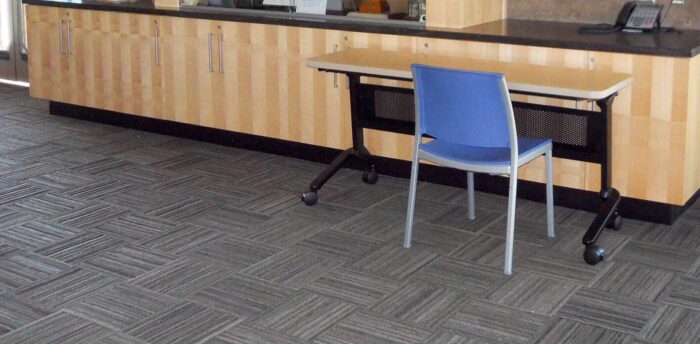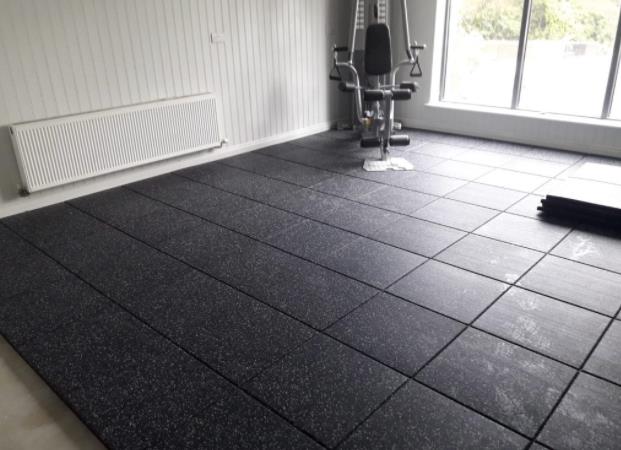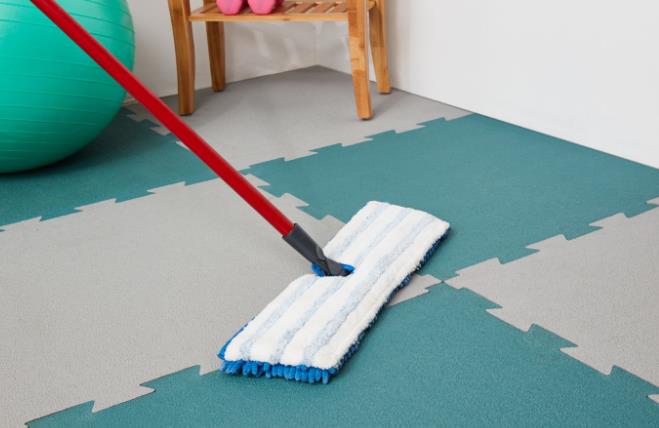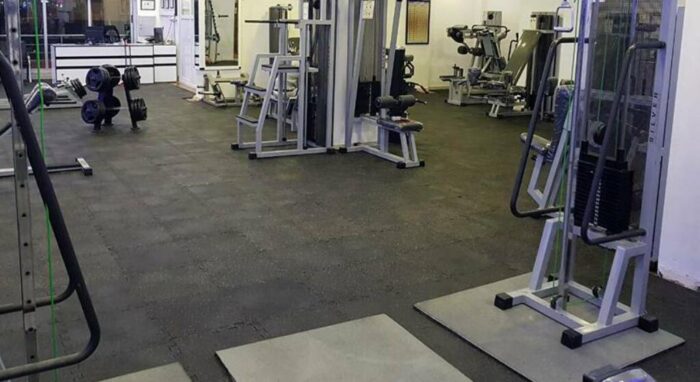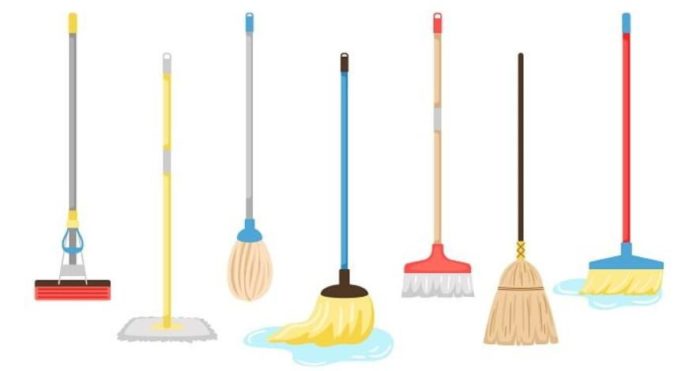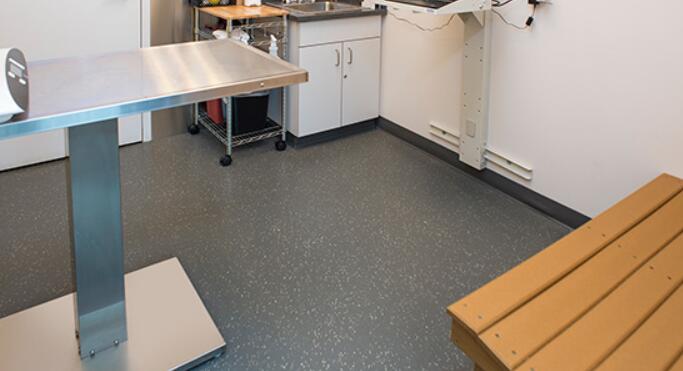Rubber flooring has been highly adopted in high-traffic environments thanks to its resilience and superb intrinsic advantages. Rubber flooring is easy to clean, wear-resistant, and durable.
Properly installing rubber flooring in a gym, playroom, basement, or laundry room is one thing but maintaining it is another. One of the standard maintenance practices done on rubber flooring is cleaning. Although rubber is by its nature moisture-resistant, preventing the growth of molds and other displeasing organisms, it has a textured surface that may trap dirt particles.
So, how to clean rubber flooring and how to care for it?
Best Way to Clean Rubber Flooring
-
Essential Tools You’ll Need for Cleaning Rubber Floors
If you want to clean your rubber flooring properly, you must first acquire all the essential tools needed in this maintenance practice. The most basic materials that should never miss in your cleaning kit include:
- A mop
Depending on availability, you can choose either a sponge mop or a right mop for rubber flooring.
- A vacuum cleaner
A rolling soft brush vacuum is the best option when cleaning rubber flooring.
- Mild detergent
Any mild pH washing chemical can be used. If the rubber flooring manufacturer advises on using a particular detergent, it is advisable to use precisely that.
- A scrubber
You may choose between a handheld rubber floor brush for a small area and a scrubber machine for an extensive rubber flooring area. Regardless of the option you go for, it is advisable to use a scrubber with softer end fibers rather than stiff ones.
-
Doing Periodic Cleaning for Rubber Flooring
Other than these, you will also need plenty of water, especially when doing thorough periodic cleaning. It will also help if you use warm water to dissolve and lather your washing chemicals effectively.
1. Follow the correct routine
The second top-secret to cleaning your rubber flooring properly is developing both a daily or weekly routine and a serial cleaning routine.
The daily or weekly routine frequency is mainly a function of the setting in which the rubber flooring is installed. In this regard, there are two main settings:
2. Household setting
If you have installed rubber flooring in your laundry area or in the house basement area, you don’t have to clean it daily.
Due to the minimized floor traffic in the home area, washing the rubber flooring once a week can duly maintain it in the perfect look.
3. Commercial setting
Rubber flooring, in commercial centers such as gyms, experience heavy foot traffic. This hence translates to a quick buildup of debris and dirt that needs to be vacuumed or cleaned daily.
On the other hand, a periodical cleaning routine is supposed to be done at least once per two months regardless of the setting it is used in. This is a thorough cleaning process that, in most cases, must involve wet vacuuming.
A well-done periodical cleaning should consume a significant amount of time as it often calls for going over some of the rubber flooring areas several times.
-
Follow the Correct Procedure
You may have the best working equipment and a well-laid cleaning routine but fail in the cleaning practice if you don’t adopt the proper washing procedure.
-
Daily or Weekly Cleaning Procedure
1. Start by removing the sizeable sized debris
It is advisable to vacuum or sweep the visible debris on your rubber flooring before proceeding to the actual cleaning procedure. This makes easy all the other subsequent cleaning processes and hence saves on the total time needed for frequent cleaning.
When using a vacuum, it would help if you tested it in another type of flooring to make sure that it works properly to avoid unnecessary damage on your rubber flooring.
2. Mop the rubber flooring
Using your cleaning agent, warm water, and your preferred mop, go over the whole rubber floored area moping it gently. A more intense moping should be done on foul and stained areas. Don’t overuse your soapy water as it may leave dirty patterns that remain on the floor even after rinsing.
3. Rinse the moped area
To eliminate all the soapy water on your flooring, use enough clean water to rinse the whole area. To flush the area properly, use water in a large bucket and pressure splash the entire flooring.
4. Dry the floor – When content that your rubber flooring is sparkling clean, remove the entire water residue using a dry mop or a wet vacuum. After this, be a little patient and allow the rubber flooring to dry on its own before using it.
-
Monthly Cleaning Procedure
All the steps you take when cleaning your rubber floors on a daily or weekly basis should be scaled up during periodic cleanups. The cleaning process should be characterized by the following:
- Extended moping a scrubbing of the flooring
- A lot of wet cleaning rather than dry techniques
- Going over areas with stubborn stains several times until they are clean.
- Use of lots of water and several mild detergents and stain remover
- Automation of most of the cleaning processes.
How to Remove Stubborn Stains from Rubber Floors?
Tough stains also find their way to rubber flooring, just like in any other type of flooring. Common stubborn stains in rubber floorings are beverage spills, paint, and oily stains. If you are struggling with removing these stains from your rubber floors, consider using these stain specific cleaning methods:
1. Vinegar for colored beverages stains
Vinegar is one food ingredient with other unlimited uses in a household. Vinegar is a perfect water-based stain remover on many household surfaces.
To remove these stains on your rubber flooring, mix equal proportions of white vinegar and water and use a minimal amount of the mixture to rub the stained area in circles using a cloth. On removal of the stain, wash the rubber flooring as in regular practice and leave it to dry before use.
2. Paint thinner for paint stains
Have you done a renovation project in your home involving the application of finishes such as paints, especially on your walls? Has the project left some parts of your rubber flooring messed up with paint stains? You need to purchase a bottle of paint thinner to remove the stubborn drips.
Before applying paint thinner on your rubber flooring, you should ensure that space is evacuated of small children and pets. Wear gloves and apply a small amount of the paint thinner on a cloth and rub the stained rubber flooring to remove the stains. Discard any exposed paint peelings, wash and again let the flooring dry.
3. Turpentine for oily stains
Precautionary measures such as wearing gloves, ventilating, and evacuating the room should be strictly followed when handling this chemical as it is highly toxic.
To remove the oil-based stains, pour three teaspoons of turpentine on a clean cloth and rub the area to lift the stains. Again wash the flooring and leave it to air dry.
Best Types of Mop for Cleaning Rubber Flooring
The mop used in rubber flooring cleaning is a vital aspect as it determines how well dirt will be removed from the flooring. Other than that, different types of mops offer a distinct level of protection to your rubber floorings throughout the cleaning process. No one would go for a mop that causes significant compromise to the shape and structure of the rubber flooring.
Many cleaning specialist recommend the microfiber dust mop as it causes minimal damage to the rubber floorings and, at the same time, do correctly, the mopping job. This mop can swipe through the flooring’s tiny trough removing the deeply hidden dirt particles.
Other mops such as the sponge mop can also be used if you want to cut on the cleaning budget for your rubber floorings.
To ensure that your mop performs the cleaning job efficiently, it is advisable to dedicate it exclusively to the rubber flooring. The use of one mop in multiple types of flooring can cause wear and tear, reducing its efficiency.
Also, the mop’s fibers should be vacuumed after each cleaning session to ensure that the attached dirt particles are not transferred to your rubber flooring in the next cleaning session.
What Not to Do When Cleaning Rubber Flooring?
Although cleaning rubber flooring is an easy and efficient management practice, care should be taken to minimize its damage when cleaning. Here are the things to avoid when cleaning rubber flooring:
1. Abrasive tools
Scars and slices may occur on your rubber flooring when you use abrasive cleaning tools. Due to this, stiff brushes and brooms should be avoided when cleaning rubber floorings. Unless you want to vacuum your rubber floorings, you should stick with the mops.
2. Harsh chemicals
High pH cleaning products and concentrated degreasers should be avoided at all cost when cleaning rubber flooring as they can lead to fading and stripping. Solvent-based cleaners should also be avoided as they have similar impacts on rubber flooring.
3. Cleaning in direct sunlight
When you clean your rubber floorings under direct sunlight, dirty cleaning water may dry up before rinsing. This may leave dirty spots on your rubber flooring even after doing a great cleaning job.
FAQs about Cleaning Rubber Flooring
1. Is rubber floor waterproof?
Yes, rubber is 100% water resistant but only when properly installed. There should be no spaces where rubber flooring tiles or rolls meet for this quality to be met.
2. Can I use bleach on rubber flooring?
Acidic chemicals should be avoided when cleaning rubber floorings. Bleaches can have negative effects, such as stripping and fading on your rubber flooring.
3. Do I need underlayment for rubber flooring?
Considering the advantages that come with underlayment, including the provision of support to the rubber flooring and reduction of sound transmission, an underlayment is needed for rubber flooring.
If the underlayment does not come with rubber flooring, you should consider buying your own.
Conclusion
Unless you properly clean and maintain your rubber flooring in the above-stipulated ways, you may not enjoy its services for a long time. While the cleaning process is simple and straightforward, it is also imperative to observe all the precautions when handling the cleaning tools and the washing chemicals.

